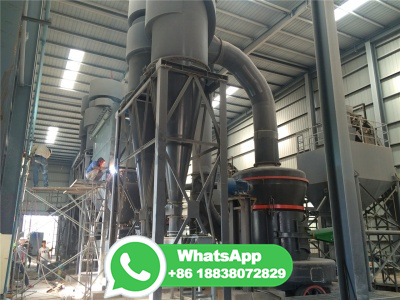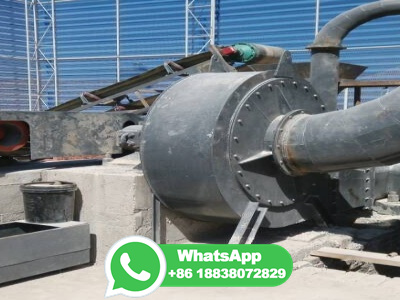
The process of peat getting buried under sediments and turning into coal continues as a cycle, as long as the conditions are suitable. This is why we see numerous layers of coal seams in certain sedimentary basins. Types of Coal. The process by which something changes under the effect of pressure and temperature is known as metamorphism in geology.
WhatsApp: +86 18203695377
So upgrading usually consists of grinding the coal and then putting into a number of froth floatation cells and cyclones in this process, the rock particles are heavier than the coal so the rock sinks and the coal floats on the surface, The coal is then skimmed off, dried to some extent and then put in train cars. Mine mouth coal for power ...
WhatsApp: +86 18203695377
In drift mines, a tunnel is dug horizontally into the side of a mountain. In slope mines, this tunnel is diagonal. In shaft mines, elevators are used to move coal through vertical tunnels. Figure c : Subsurface mining involves digging tunnels to access coal deposits that are deep underground.
WhatsApp: +86 18203695377
The process of turning coal into diamonds is called carbonadoing and it can take anywhere from a few weeks to a few months. The first step is to put the coal in a crushing machine to turn it into a fine powder. Next, the powder is placed in a container called a retort where it is heated to about 2,700 degrees Fahrenheit. This causes the carbon ...
WhatsApp: +86 18203695377
Th e process of converting coal into electricity has multiple steps and is similar to the process used to convert oil and natural gas into electricity: 1. A machine called a pulverizer grinds the coal into a fi ne powder. 2. Th e coal powder mixes with hot air, which helps the coal burn more effi ciently, and the mixture moves to the furnace. 3.
WhatsApp: +86 18203695377
Metallurgical Coke (Metcoke) is a source of carbon for solar silicon smelting. It is a porous, carbonrich solid fuel made by "coking" coal in large "slot ovens" to drive out most of the ...
WhatsApp: +86 18203695377
Conversion of coal to diamonds is a natural process that takes millions of years. Even though there are carbon atoms in coal, the amount of impurities are so high, that it takes millions and millions of years for the coal to transform to its nearly purest form graphite. The conversion of graphite to diamonds takes some more millions of years.
WhatsApp: +86 18203695377
Coal Rank. Coalification is the process of metamorphism that takes place with time under conditions of increasing pressure and temperature. The original peat swamp vegetation is transformed to brown coal, lignite, subbituminous coal, bituminous coal (low, medium, high rank), semianthracite, anthracite, metaanthracite by the loss of moisture ...
WhatsApp: +86 18203695377
Uses of Coal. It is mainly used to generate heat and electricity. It is used in s and in industries to accomplish various tasks. It is the cheapest source of power fuel. The iron and steel industry depends heavily on fossil fuel for energy. It is also used to produce useful products such as coke, tar, and coal gas.
WhatsApp: +86 18203695377
Despite the slump, West ia added 1,500 coal mining jobs in 2022 and employed by far more miners than any other state at 13,000, which is 30% of the total coalmining employment ...
WhatsApp: +86 18203695377
Metallurgical coal, also known as coking coal, is used to produce coke, the primary source of carbon used in steelmaking. Coal is a naturally occurring sedimentary rock formed over millions of years as plants and other organic materials are buried and subjected to geological forces. Heat and pressure cause physical and chemical changes that ...
WhatsApp: +86 18203695377
the process to dissolve the coal and to transfer externally produced hydrogen to the coal molecules. Catalytic liquefaction resembles solvent extraction, except that hydrogen is added to the coal with the aid of a catalyst. Figure presents the flow diagram of a typical solvent extraction or catalytic
WhatsApp: +86 18203695377
In this study, coal fly ash was functionalized, using a simple onestep process (loading with Al3+ and sulfonation), to yield a solid acid catalyst (S/AlCFA) with strong acid sites. The catalyst was then used to produce furfural from xylose in a biphasic system (H2O(NaCl)/tetrahydrofuran). The furfural yield reached 82% at 180 °C60 min with catalyst/xylose ratio of : (w/w). With the ...
WhatsApp: +86 18203695377
The process of coal formation is known as coalification. The following are the steps for the process of formation of coal: (Peat rightarrow Lignite rightarrow Bituminous rightarrow Anthracite) Peat Formation: This is the first stage of coal formation. It is an organic substance formed due to the partial decomposition of dead matter.
WhatsApp: +86 18203695377
It takes millions of years to create and as a nonrenewable resource, there is only a finite amount.
WhatsApp: +86 18203695377
Processing coal After removing the coal from the ground, miners may send it to a preparation plant near the mining site. The plant cleans and processes coal to remove rocks, dirt, ash, sulfur, and other unwanted materials. This process increases the heating value of the coal. Transporting coal
WhatsApp: +86 18203695377
Formation of Coal. Coalification is a process in which dead matters like plants and vegetation convert into coal over a prolonged period of time. In the past geological times, the Earth was covered with dense forests, especially in the wetland areas.
WhatsApp: +86 18203695377
Coal is not a probable carbon source for this diamondforming process. The most likely carbon sources from the subduction of an oceanic plate are carbonate rocks such as limestone, marble, and dolomite, and possibly particles of plant debris in offshore sediments.
WhatsApp: +86 18203695377
Coal, one of the world's most impactful fossil fuels, was formed millions of years ago, in very specific conditions. Most of the coal on Earth formed approximately 300 million years ago from the ...
WhatsApp: +86 18203695377
The Texaco process, including its modifications, and the KoppersTotzek design are basically entrained bed systems (Clark, 1978; Koh, 1982).They therefore require the coal to be fed as a fine particle dust, or, more reliably, as a water slurry, in order to prevent the breakthrough of oxygen and consequential risks of explosion.
WhatsApp: +86 18203695377
The Department of Energy explains that coal gasification is a thermochemical process in which the gasifier's heat and pressure break down coal into its chemical constituents. The resulting "syngas" is comprised primarily of carbon monoxide and hydrogen, and occasionally other gaseous compounds. Proponents of coal gasification say that ...
WhatsApp: +86 18203695377